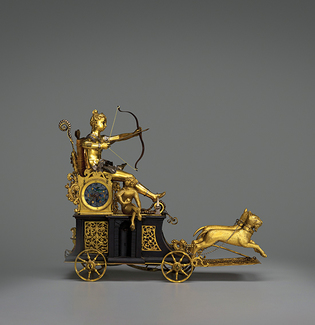
Yale University Art Gallery
After four centuries, this clockwork Diana is still going—literally. Wind her up, and the goddess, her chariot, and her animals will stage a hunt. The elaborate mechanical artwork is on display this summer at the Yale University Art Gallery, and it will be included in the gallery’s forthcoming exhibition of historical scientific instruments from Yale’s collections.
View full image
To a modern-day viewer, the most prominent feature of this early-seventeenth-century moving clockwork is its form: a chariot pulled by two leopards and carrying the Roman goddess Diana. Equipped with the attributes associated with her oft-depicted identity as a huntress, Diana wears a quiver strapped over her shoulder and holds her bow and arrow. She is in the company of a monkey, which—in a humanized, satirical pose—is seated, with its legs crossed and holding an apple in one hand. The goddess, with her accoutrements, throne-like seat, and animal companions, as well as the decorative openwork panels and plates attached to the chariot, were forged with gilt bronze and silver. Made in Germany, the clock was donated to the Yale University Art Gallery by Florence Maconaughy in honor of her late husband, Laird Shields Goldsborough, Class of 1924.
This clock is no ordinary clock. It is one of many once-popular devices called automata, a term that describes a wide range of self-moving machines. Despite its purported autonomy, an automaton is immobile until activated by the human hand. The idea and making of self-operating objects existed for millennia in several parts of the world. A spring-driven automaton clock first appeared in Europe during the fourteenth century, with the production of large clocks that were installed in religious and civic buildings. Automaton clocks became a specialty of artisans working in southern Germany in the sixteenth and seventeenth centuries.
In the case of the Diana clock, which was made around 1610, each side of the goddess’s throne is embedded with a clock dial decorated with floral and aviary motifs in colored enamel. Inside the throne is a spring-driven set of wheels that guides the hands of the dials on either side—a 12-hour cycle on one side and a 24-hour cycle on the other. The chariot underneath the throne contains two additional series of gears that enable the striking of bells on the quarter hour, as well as much of the automaton’s locomotion.
Once the automaton is activated, Diana’s eyes rotate, the chariot moves forward in a slow and steady pace, the leopards leap up and down as their heads oscillate, and the monkey nods its head and lifts its right arm. Moments before the chariot stops, a bird perched on the back of the chariot flaps its wings, and Diana’s eyes stop moving. When the chariot comes to a halt, the goddess releases an arrow with her right middle finger.
This clock was most likely produced in Augsburg, a leading center of metalsmithing, clockmaking, and cabinet making in Germany during the sixteenth and seventeenth centuries. It would have been made by artisans of these trades working closely with a gilder, an engraver, and an enamellist. The piece is a testament to the artisanal virtuosity and collaboration involved in the production of an automaton clock.
Exquisite European automaton clocks like this one were produced for the wealthiest and most powerful. They were usually commissioned, gifted for diplomatic purposes, or shown in intimate settings, such as a banquet for kings and nobility, or a princely collection—called a “cabinet of curiosities”—of natural specimens, man-made objects, scientific instruments, and goods from outside Europe. Diana’s chariot would have been appreciated by its audience at the time of its creation. Centuries later, it was celebrated with great fanfare at exhibitions in the Fine Arts Museums of San Francisco in 1977 and the Metropolitan Museum of Art, New York, in 2015. A video of the clock in motion remains the gallery’s most watched video on YouTube (https://youtu.be/u6ro4zscyE0).
While the metallic figures and animals immediately capture our attention, the ebony chariot in the shape of a miniature architectural structure deserves a closer look. Since ancient times, ebony had been a prized material sourced from Africa and South and Southeast Asia. Relished for its durability, color, and highly smooth surface when polished, this costly tropical wood was employed for producing small cabinets and portable automata in Augsburg and elsewhere in Germany, starting in the sixteenth century. This type of ebony, used in Europe from that period onwards, was usually acquired at the expense of enslaved peoples in colonized territories: as art historian Claudia Swan has pointed out, they suffered the backbreaking labor of logging and preparing ebony trees. Such histories often go untold in descriptions of eye-catching objects like this clock.
 loading
loading